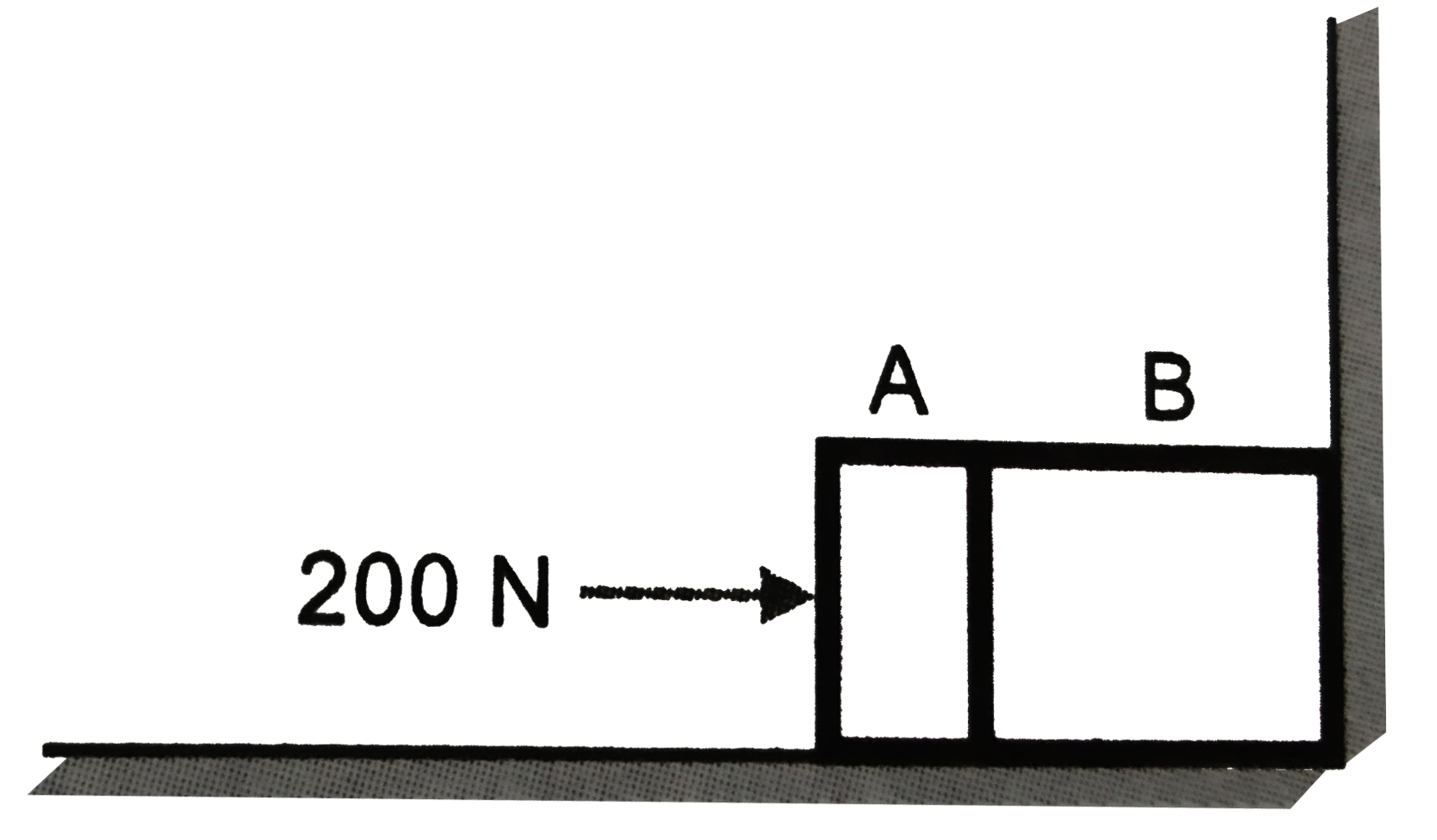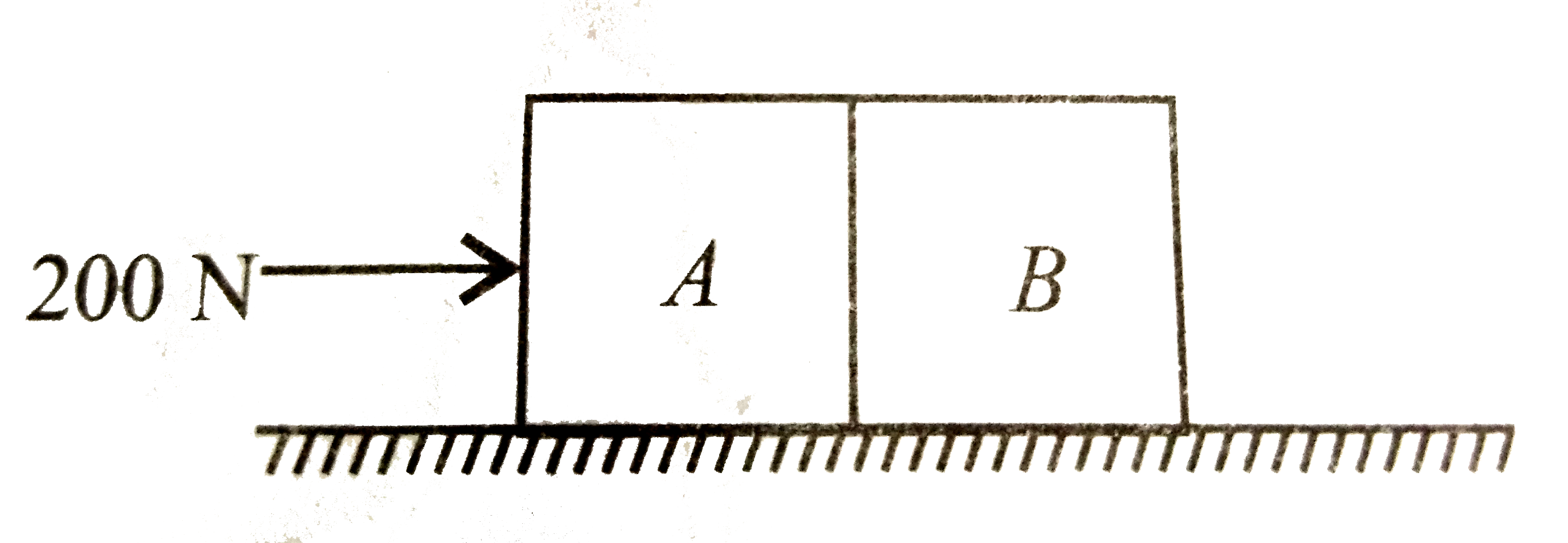Two bodies A and B of masses 5 kg and 10 kg in contact with each other rest on a table against a rigid wall . The coefficient of friction between the bodies and the table is 0.15. A force of 200 N is applied horizontally to A. What are (a) the reaction of the partition (b) the action-reaction forces between A and B ? What happens when the wall is removed? Does the answer to (b) change, when the bodies are in motion? Ignore the difference between μs and μk

We assume perfect contact between bodies A and B and the rigid partition. In that case, the self-adjusting normal force on B by the partition (reaction) equals 200 N. There is no impending motion and no friction. The action-reaction forces between A and B are also 200 N. When the partition is removed, kinetic friction comes into play.
Acceleration of A+B=[200−(150×0.15)]/15=11.8ms−2
Friction on A=0.15×50=7.5N
200−7.5−FAB=5×11.8
FAB=1.3×102N , opposite to motion
FBA=1.3×102N , in the direction of motion
Related Playlists
- BOOK - NCERT GUJARATICHAPTER - LAW OF MOTIONEXERCISE - EXERCISE23videos
LAW OF MOTION
- BOOK - NCERT GUJARATICHAPTER - KINETIC THEORYEXERCISE - ADDITIONAL EXERCISE4videos
KINETIC THEORY
- BOOK - NCERT GUJARATICHAPTER - MECHANICAL PROPERTIES OF FLUIDS EXERCISE - EXERCISE31videos
MECHANICAL PROPERTIES OF FLUIDS
Similar Questions
Two bodies A and B of masses 5 kg and 10 kg in contact with each other rest on a table against a rigid wall as shown in fig. The coefficient of friction between the bodies and the table is 0.15. A force 200 N is applied horizontally to A. What are
(a) the reaction of the partition
(b) the action-reaction forces between A and B ?
(c) What happens when the wall is removed? Does the answer to (b) change, when the bodies are in motion? Ignore the difference between μs and μk
 View Solution
View SolutionTwo bodies A and B of mass 5 kg and 10 kg contact with each other rest on a table against a rigid The coefficient of friction between the bodies and the table is 0.15 A force of 200 N is applied horizontal on A What are (a) the reaction of thee wall (b) the the action , reaction forces between A & B ? What happens when the wall is removed ? Does the answer to (b) Change , when the bodies are in motion ? Ignore differnce between μs and μk
 . View Solution
. View SolutionTwo bodies A and B of mass 5 kg and 10 kg contact with each other rest on a table against a rigid The coefficient of friction between the bodies and the table is 0.05 A force of 200 N is applied horizontal on A What are (a) the reaction of thee wall (b) the the action , reaction forces between A & B ? What happens when the wall is removed ? Does the answer to (b) Change , when the bodies are in motion ? Ignore differnce between μs and μk
 . View Solution
. View SolutionTwo bodies A and B of mass 5 kg and 10 kg contact with each other rest on a table against a rigid The coefficient of friction between the bodies and the table is 0.05 A force of 200 N is applied horizontal on A What are (a) the reaction of thee wall (b) the the action , reaction forces between A & B ? What happens when the wall is removed ? Does the answer to (b) Change , when the bodies are in motion ? Ignore differnce between μs and μk
 . View Solution
. View SolutionA body of mass 2 kg at rest on a horizontal table. The coefficient of friction between the body and the table is 0.3 . A force of 5N is applied on the body. The force of friction is
View SolutionA body of mass 2kg is at rest on a horizontal table. The coefficient of friction between the body and the table is 0.3 . A force of 5N is applied on the body. The acceleration of the body is.
View SolutionTwo blocks A and B of masses 10 kg and 15 kg are placed in contact with each other rest on a rough horizontal surface as shown in the figure. The coefficient of friction between the blocks and surface is 0.2. A horizontal force of 200 N is applied to block A. The acceleration of the system is (Take g=10ms−2)
 View Solution
View SolutionTwo blocks A and B of masses 10 kg and 15 kg are placed in contact with each other rest on a rough horizontal surface as shown in the figure. The coefficient of friction between the blocks and surface is 0.2. A horizontal force of 200 N is applied to block A. The acceleration of the system is (Take g=10ms−2)
 View Solution
View SolutionA block of mass 2 kg is at rest on a floor . The coefficient of static friction between block and the floor is 0.54. A horizonatl force of 2.8 N is applied to the block . What should be the frictional force between the block and the floor ? ( take , g=10m/s2)
View SolutionA block A of mass 2 kg rests on another block B of mass 8 kg which rests on a horizontal floor. The coefficient of friction between A and B is 0.2 while that between B and floor is 0.5. when a horizontal force of 25 N is applied on the block B. the force of friction between A and B is
View Solution

